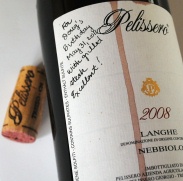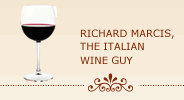fine Italian Wines to greet spring
Wine for march - Under $25
Fatalone, Gioia del Colle DOC Primitivo 2007 (about $17)
I recently sampled a 2007 Fatalone Primitivo at an informal tasting of Zinfandel and Primitivo wines hosted by some long-time friends. While the Zinfandel and Primitivo varietals are genetically related, they are distinct and can produce a wide array of styles of wines, some of which are wonderful.
While the Fatalona Primitivo was not the tasting favorite - it was up against some very expensive California Zinfandels - it did relatively well and garnered some very positive comments. I especially enjoyed the warm Mediterranean flavors of the wine and its relatively low $17 price tag was an added bonus. The label also indicated it was certified organic. However, I wasn’t even remotely familiar with the producer even though I have traveled throughout the Gioia del Colle zone in the Puglia region of southern Italy. I clearly needed to find out more about the wine and its producer.
It turns out that the Fatalone Primitivo is produced by a small but highly regarded biodynamic winery - Azienda Agricola Pasquale Petrera - in the Gioia del Colle DOC zone in the Trulli district of Puglia. Owned and managed by the Petrera family since the late 1800’s, the estate today has 15 acres of vineyards from which it produces three different Primitivo wines and a Greco white wine. The winery uses only estate-grown grapes in the production of its wines and was the first to produce a Gioia del Colle DOC Primitivo as a single varietal wine.
All aspects of the winery’s operations, from vineyard management through fermentation and cellaring, are conducted on a biodynamic basis with minimal intervention in the winemaking process. Additionally, the entire winery is run by solar power so the complete production cycle is 100 percent sustainable. The winery is certified organic by the Institute for Ecology and Ethics and follows the standards established by the U.S.’s National Organic Program.
So this is all well and good but what about the wine? The ’07 Fatalone Primitivo is 100 percent Primitivo from the estate’s own vineyards. The grapes are hand-harvested in late September and then undergo a long, slow fermentation process. The wine is then aged for six months in stainless steel tanks followed by six additional months in oak casks. The wine is then bottled where it spends an additional six months prior to release for sale.
The Fatalone Primitivo checks in at 15 percent alcohol, which is high compared to most Italian wines but not unusual for Primitivo wines. It is an intense wine that will appeal to those who like big wines and then like to crank it up a notch. It is big, intense and complex with enough mouth-filling dark fruit flavors to boggle Bacchus. But the wine is nicely textured and balanced. The black cherry, plum and kitchen spice flavors are complemented by soft tannins and gentle acidity. The wine, while dry, has just a touch of sweetness on the finish.
The ’07 Fatalone Primitivo is delicious, generous and a lot of fun to drink. It is the ideal companion to barbequed beef, kabobs, roast beef, lamb, game and medium-aged cheeses.
Imported by Williams Corner Wine of Charlottesville, VA.
Wine for march – $25 and over
Pelissero, Langhe Nebbiolo 2008 (about $26)
The Pelissero winery is a small, high-quality estate located in the Tresio district of the Langhe region, which is the heart of the Barbaresco zone. The Pelissero family has been farming the hills in the Tresio area for generations but it wasn’t until 1960 that they began commercially bottling their own estate-grown grapes.
Today, the estate consists of approximately 50 acres from which it produces a number of traditional red and white wines from their Barbera, Nebbiolo, Dolcetto, Grignolino, Favorita and Freisa vineyards. The Pelissero winery is a highly regarded winery that emphasizes attention to the details of all its vineyard and cellar operations in producing classic wines that haven’t been overtly manipulated.
The Pelissero estate produces a number of Nebbiolo-based wines including several different Barbaresco labels, a Nebbiolo-Barbera blend in addition to a Nebbiolo wine from the Langhe Nebbiolo DOC.
The Langhe DOC zone came into existence in the 1990’s to cover wines made in the Langhe zone that for one reason or another do not meet the requirement s of the existing DOC and DOCG’s such as Barolo, Barbaresco, Dolcetto d'Alba or Barbera d'Alba, among others. It is a large geographic zone that encompasses all the DOC and DOCG designated areas in the Langhe area. The rationale behind the Langhe DOC is to provide vintners with a more flexible format for producing wines while providing a quality designation other than the lowly Vino da Tavola. Nebbiolo is one of six varietal wines that can be produced in the Langhe DOC.
s of the existing DOC and DOCG’s such as Barolo, Barbaresco, Dolcetto d'Alba or Barbera d'Alba, among others. It is a large geographic zone that encompasses all the DOC and DOCG designated areas in the Langhe area. The rationale behind the Langhe DOC is to provide vintners with a more flexible format for producing wines while providing a quality designation other than the lowly Vino da Tavola. Nebbiolo is one of six varietal wines that can be produced in the Langhe DOC.
Like the famed Barbaresco wines, Langhe Nebbiolo wines are made entirely of Nebbiolo grapes. However, some of the grapes may come from vineyards outside the Barbaresco-designated zone and/or from more recently planted vineyards that wouldn’t qualify for Barbaresco. In addition, whereas Barbaresco wines need some years in the bottle to develop their true character, Langhe Nebbiolo wines do not need extensive aging to develope their personality. They are more approachable and, hence, less expensive than Barbaresco wines. Prices of Langhe Nebbiolo wines usually fall in the $20-$30 range while Barbarescos typically bear price tags that range north of $50.
Think of them as “baby Barbarescos.” While they are more youthful and full of spirit than the gravitas-laden Barbaresco wines, a well-made Langhe Nebbiolo wine will proffer Barbaresco’s acclaimed earthy aromas and subtle red fruit flavors. Langhe Nebbiolo wines typically have good tannins and acidity, which enable them pair well with a wide variety of dishes such as roast pork over polenta, risotto with shaved truffles, sausages and a variety of pasta dishes.
After a short fermentation, Pelissero’s 2008 Langhe Nebbiolo wine was aged partly in small wooden barrels (barriques) and partly in large oak casks. After 9 months, the two components were blended and bottled where they spent an additional two months prior to release for sale.
The ’08 Pelissero Langhe Nebbiolo has a deep ruby color and aromatic herb and red berry aromas that lead to ripe cherry flavors. It is well structured with soft tannins and lively acidity. It is a playful but elegant wine with pleasant aromas, supple with rich fruity notes and a long, lingering finish. It has all the flavors of the Piedmont at a reasonable price.
Imported by Vinifera Imports Ltd.
©Richard Marcis
March 6, 2012
To view other wine of the month selections, see Monthly Wine Reviews



